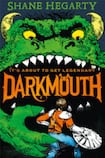
Some years ago I went on BBC Radio 4's Today programme to justify the scary nature of some modern children's literature to John Humphrys, the show's formidable host, a man known to eat errant guests for breakfast and spend the rest of the day merrily sucking the marrow from their bones. Apparently Humphrys jnr had been reading a children's book that Humphrys snr felt was a bit much, and I was to be the sacrificial lamb, in large part because I'd written the book that caused all the trouble.
I’d like to think that I mounted a stirring and successful defence of the (mildly) terrifying in children’s novels, although the resultant bruising I sustained leads me to suspect I did not. It came down, I suppose, to what is too frightening, but that’s entirely subjective, and tied up with questions of taste and maturity. It’s an issue for children’s booksellers, because being asked by a parent if a certain book is suitable reading material rather begs the question: how well do you know your child?
There is also, of course, a huge difference between being pleasantly scared and the kind of terror that leads to therapy, and court cases. Some of my earliest memories of reading are linked to the supernatural – although largely involving work written for adults, as there really weren’t enough scary stories aimed at younger readers to feed my appetite – and I seem to have turned out all right, relatively speaking.

If something that I was reading proved too frightening, then I simply closed the book. This is one of the crucial differences between peril in cinema or TV and peril in literature. With a book the reader retains a great deal of control. In a film or TV show the nature and intensity of the images are entirely beyond the viewer’s regulation, which is why children cover their faces when it all becomes intolerable – it’s the only response available to them.
That paucity of creepy literature for children is now a thing of the past, and Irish novelists such as Derek Landy and Darren Shan have shown themselves to be particularly adept at filling this gap in the young-adult market. Along with Eoin Colfer and Celine Kiernan, among others, they also represent the continuation of a noble tradition of Irish fantasy writing that, until recently, had been largely abandoned or ignored by creators of adult fiction.
While this country provided four masterpieces of the 19th-century Gothic tradition – Charles Maturin's Melmoth the Wanderer, Sheridan Le Fanu's Uncle Silas, The Picture of Dorian Gray by Oscar Wilde and Dracula by Bram Stoker – and even Mary Shelley's Frankenstein found time for a detour here, Irish novelists of the last century generally eschewed outright fantasy, with the honourable exceptions of Flann O'Brien's wilder flights of fancy, and the neglected work of comic genius that is Mervyn Wall's The Unfortunate Fursey.
It was as though independence and new nationhood placed a requirement of seriousness upon Irish fiction against which few writers were prepared to stand. Mythology and folklore initially proved useful as part of the process of establishing a national identity separate from England – "Folk art," wrote WB Yeats in The Celtic Twilight, "is indeed the oldest of the aristocracies of thought . . . it is the soil where all great art is rooted" – but their value to the literary culture of the nascent Irish state was less certain. After all, what place had genre fiction in a land that still had sexual repression, rural isolation and the legacy of centuries of oppression to mine for subject matter?
Welcome to the fray
With all that in mind it’s a pleasure to welcome
Shane Hegarty
, the
Irish Times
journalist, to the modern fantasy fray with his debut novel,
Darkmouth
. No higher praise can be offered than to say that this is a book Mervyn Wall might well have enjoyed, for Hegarty’s hero, Finn, carries within him something of Fursey’s DNA. Finn is mildly incompetent, majorly terrified, and spends a good part of
Darkmouth
making the very sensible decision to run away from whatever toothed monstrosity happens to be in his vicinity at the time.
The town of Darkmouth (which appears to be in Ireland, although there’s a degree of forgivable geographical fudging going on, probably to cater to the demands of the international market) is the last of the Blighted Villages. These hamlets were so named because they were gateways for Legends – creatures from myth and fable living in an unpleasant alternative universe, and very anxious to make the transition to the more amenable surroundings of our own.
Darkmouth is currently under the guardianship of Legend Hunter Hugo, who is training his reluctant son Finn to follow in his footsteps. But Finn, rather than painfully reducing Legends to semi-sentient balls of flesh and fur with high-tech weapons known as Dessicators, would prefer to become a vet. He’s also not much cop at being a Legend Hunter, at least not at the start, even managing to sink a passing trawler with a misplaced Dessicator shot.
Like Wall’s desperately unlucky monk, who was unable to save his monastery from the forces of darkness because of a stammer that prevented him from properly performing the rite of exorcism, Finn’s apparent deficiencies threaten to leave his community vulnerable to invasion and, ultimately, destruction. On top of all this Finn is also, in the best tradition of awkward teenage male protagonists, hopeless with the opposite sex, represented by the ambiguous redheaded figure of Emmie, a recent arrival in Darkmouth. But there is, of course, more to Finn than meets the eye.
David Walliams
Hegarty shares a UK publisher with David Walliams, the new king of children’s writing, and it’s not difficult to see a potential commonality of readership.
Like Walliams – and, indeed, Landy – Hegarty understands the importance of humour for young readers. One of the great pleasures of being scared is the release of laughter that comes afterwards, and Darkmouth is peppered with sly, gentle wit, even down to Darkmouth's population sign, which regularly has to be altered by hand to account for unfortunate demises.
While the obvious point of comparison initially appears to be Rick Riordan’s Percy Jackson novels, which are also steeped in mythology, Hegarty’s touch is lighter than Riordan’s, and his sensibility more surreal. There are hints of Terry Pratchett – no bad thing – and, inevitably, of JK Rowling, the great elephant in the corner, but Hegarty’s voice is his own.
With its illustrations and well-spaced typeface, Darkmouth is clearly aimed at the younger section of the children's market. It's less YA than just Y, but the more mature end of the fantasy market has become increasingly crowded, and a novel such as Darkmouth provides a good point of entry for preteens, although older readers will also find much to enjoy here.
The second novel in the sequence is promised for later this year, which means that we’ll be seeing more of Finn, and reading more of Hegarty. Already, 2015 is starting to look a lot more cheerful.
John Connolly's latest novel is The Wolf in Winter











